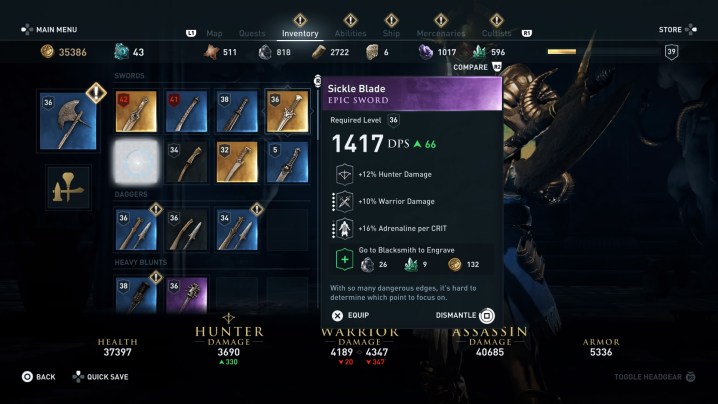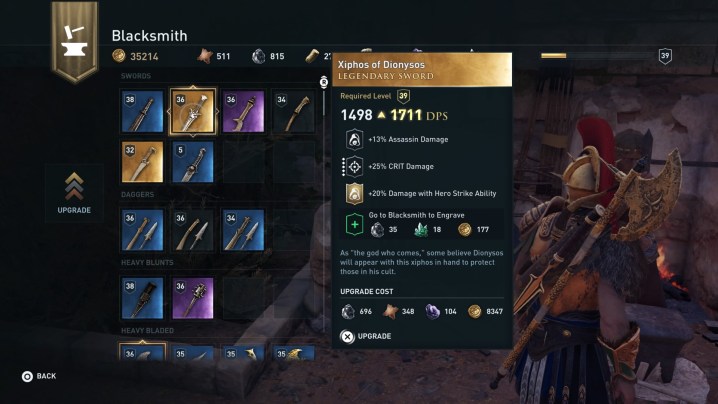
Assassin’s Creed Odyssey has more systems at play than any other entry in the series before it. Ubisoft’s turn to full action RPG means that you have to approach this Ancient Greece-themed adventure differently. From paying attention to gear to skill upgrades to handling the game’s many distractions, we’ve learned a lot in our 50 hours with Odyssey. To help you get started off right, we’ve put together a beginner’s guide filled with tips that should make your journey across this massive world a bit easier.
Choose a character

Assassin’s Creed Odyssey marks the first time you can choose your character. You have two choices: Alexios or Kassandra. In truth, it doesn’t matter who you pick, so don’t fret over it too much. Both Alexios and Kassandra have the same movesets, skill trees, dialogue options, and storylines. The only difference is the delivery of their lines, with Alexios coming off more aggressive while Kassandra is more cunning.
Dismantle unneeded gear

As an RPG, each weapon and piece of armor has a level requirement and a point value (attack for melee weapons and bows, and defense for chest pieces, helmets, pants, and bracers). You will pick up gear from slain enemies, by completing missions, in chests, and elsewhere. That means you’ll grab new gear every few minutes or so. What should you do with the gear you don’t need? You can sell it to the blacksmith if you so choose, but we don’t recommend doing so.
You earn enough drachmae (in-game money) by simply completing missions and looting. What you really need is soft leather and iron metal, two items that allow you to upgrade your existing gear to your current level at the blacksmith. These are the two items that we often found we didn’t always have enough of, so dismantling unneeded gear is key.
Here’s the thing: While you pick up new gear rather quickly, you often don’t pick up gear that advances your attack or defense, or is even at your current level. You can solve this dilemma by upgrading your gear to keep your attack and defense comparable to your character level.
Upgrade Epic/Legendary gear

Gear is separated into four categories: Common, Rare, Epic, and Legendary. Common gear has one engraving buff (a stat boost), Rare gear has two, and Epic and Legendary have three stat boosts. For that reason, you should always try to have Epic/Legendary gear equipped. It’s also rarely smart to spend your materials on upgrades for gear that falls below the Epic threshold.
Ideally, upgrading Legendary gear is always preferable, since Legendary gear usually has better boosts and a higher point value than Epic gear of the same level. For instance, early on you get a Legendary sword from a key story beat. We used that sword, which started off at level 10, all the way up to level 30, simply because it was a better option than the other gear we picked up in the ensuing hours.
Engrave weapons and armor

While weapons and armor start off with one to three stat boosts, you can add an additional boost by engraving at the blacksmith. Engraving is cheap and doesn’t require many materials, but it can make a big difference. For example, we were able to add an additional eight percent damage to all Spartan soldiers by engraving an already powerful legendary sword. Since engraving doesn’t require you to spend as much as upgrades, if you’re in a pinch, it’s not a bad idea to get a bit of a boost if you’re struggling with enemies with your current gear.
Unlock skill upgrades

Assassin’s Creed Odyssey has a skill tree with three different paths: One for your bow, one for melee weapons, and one for stealth. Each skill also has three tiers, so it’s a larger skill tree than it looks. As you wade deeper into the game, you’ll be able to purchase most of the skills.
Each time you level up, you get a skill point to spend. In the early going, however, you want to be smart with how you spend your skill points. One of the very first skills you should acquire is Second Wind in the Warrior class. Second Wind is a health regeneration skill that is crucial as you find your footing.
Besides the health skill, you should focus on your play style. If you want to try and be stealthy, focus on Assassin skills. If you want to play Odyssey like a close-range action game, scoop up Warrior skills. And if you like ranged attacks, the Hunter class is all about bow skills.
Use Ikaros

Just like Assassin’s Creed Origins, you can take to the skies with a trusty bird to survey the landscape before making your move on foot. As you approach mission objectives, the game will frequently tell you to call upon Ikaros to find the exact location of an objective. This is the bare minimum of using Ikaros, though, and you should make use of the helpful bird way more.
By pressing up on the d-pad at any time, you can take hold of Ikaros. When clearing out a base, it’s advisable to use Ikaros to mark enemies, treasure chests, and wars supplies that need to be burned. Rather than fumbling around looking for points of interest, you can press L2/LT to freeze Ikaros and look around until points of interest are marked. This will save you a lot of time and headaches. Plus, it helps you fully complete fortresses and buildings with enemies in them (dubbed Locations), which nets you experience points.
Watch for Mercenaries and pay bounties

Odyssey has a morality system that comes into play. Fashioned like Grand Theft Auto’s police system, if you do bad things, you’ll get a bounty on your head. At any time, one to five mercenaries could be seeking you out if and when you kill civilians, steal items, or even kill enemy soldiers. You can’t avoid mercenaries altogether, but you can be aware of their locations. They are marked on the map with helmets.
If the helmet is red, that means the mercenary is coming after you. Like we talked about in our Assassin’s Creed Odyssey review, Mercenaries can get particularly annoying, especially when you’re inside an enemy fortress since you’re already dealing with a bunch of enemies. It’s smart to either pay mercenaries off when you first attract them or focus your efforts on meeting them halfway to kill them before they catch you at a bad time.
Be aware that sometimes these mercenaries will be much higher in level than you. In that case, it’s always best to run, hide, and then pay them off in the menu (by holding Triangle/Y on the map screen).
Master parrying

Odyssey‘s combat mirrors that of Origins. If you didn’t play Origins, know that it’s more methodical and less forgiving than the earlier games in the series. It revolves around a two trigger melee system of light and heavy attacks. Heavy attacks knock down defenses of shielded enemies, while light attacks are quicker and easier to land. The move you should pay the closest attention to is parrying (LT + RT or L2 + R2).
When an enemy is about to attack, their weapon will glimmer for a moment, letting you know that it’s time to initiate a parry. The timing is fairly forgiving so it’s not a particularly challenging move to pull off, but it is an incredibly important one. A successful parry gives you a window to unleash multiple attacks and often knock the enemy off their feet. Parries are especially important in boss battles and when fighting high-powered enemies such as captains, mercenaries, and polemarchs.
Loot, loot, loot

Everywhere you turn in Odyssey there’s something to loot. Whether it be a small bag of drachmae, a bountiful treasure chest, a weapon rack, or from dead soldiers. It’s easy to brush over some of these opportunities, but you should loot as much as you can stomach. It’s not uncommon to find a useful piece of gear on a weapon rack or a few pieces of iron metal on a table. The most important looting opportunities come when killing high-value targets (difficult enemies) and from chests in forts. Both of these almost always reward you with new weapons, a decent amount of coin, and desired materials. So when you down a Spartan polemarch, please don’t forget to take their gear.
Seek out synchronization spots

Remember how old Assassin’s Creed games had towering structures that you performed breath-defying Leaps of Faith from the highest city points into a barrel of hay? That’s still a feature in Odyssey, though the structures, save for a few statues, are rarely very high in the air (it’s set in Ancient Greece after all).
These synchronization points, marked as birds on the map, are very important. Each time you unlock a synchronization point, you can fast travel to that location. Trust us, despite Odyssey‘s beauty and detail, you’ll want to fast travel often. The map is enormous. Each time you see a bird icon around you, you should go activate that spot, even if it’s a bit out of your way. You’ll be happy you did later.
Tackle sidequests

Assassin’s Creed Odyssey turns into a grind at around the halfway point. You won’t be able to just complete story missions. For that reason, if you see a sidequest (marked with an exclamation point) nearby, you should think twice before passing it up. Not only do sidequests typically take half the time of story missions, but they net you similar amounts of experience points.
Similarly, if you come across an enemy fortress (a large Athenian or Spartan stronghold), you should complete the location objectives. Location objectives typically involve killing the fort’s leaders, looting chests, and burning war supplies. If you complete all of these objectives, you’ll earn about the same amount of experience points as you would in a mission while getting a bunch of new gear and materials.


